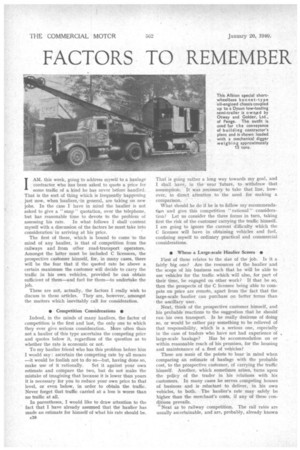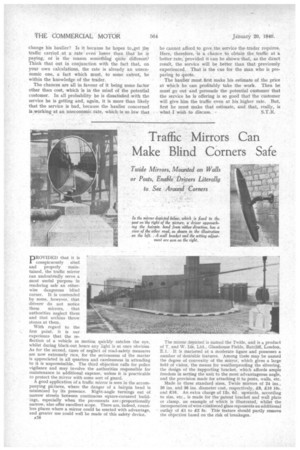FACTORS TO REMEMBER WHEN QUOTING FOR A JOB
Page 36

Page 37

Page 38

If you've noticed an error in this article please click here to report it so we can fix it.
Solving the Problems of the Carrier
Enumeration and Discussion of the .Points Which a Haulier Should Take Into Consideration When He is Quoting for New Traffics IAM, this week, going to address myself to a haulage contractor, who has been asked to quote a price for some traffic of a kind he has never before handled. That is the sort of thing which is frequently happening just now, when hauliers, in general, are taking on new jobs. In the case I have in mind the haulier is not asked to give a " snap " quotation, over the telephone, but has reasonable time to devote to the problem of
assessing his rate. In what follows I shall content myself with a discussion of the factors he must take into consideration" in arriving at his price.
The first of these, which is bound to come to the mind of any haulier, is that of competition from the railways and from other road-transport operators. Amongst the latter must be included C licensees, the prospective customer himself, for, in many cases, there will be the fear that if the quoted rate be above a certain maximum the customer will decide to carry the traffic in his own vehicles, provided he can obtain sufficient of them—and fuel for them—to undertake the job.
These are not, actually, the factors I really wish to discuss in these articles. They are, however, amongst the matters which inevitably call for consideration.
• Competition Considerations • Indeed, in the minds of many hauliers, the factor of competition is the first and last, the only one to which they ever give serious consideration. More often than not a haulier of this type ascertains the competing price and quotes below it, regardless of the question as to whether the rate is economic or not.
To my haulier friend who has this problem before him I would say : ascertain the competing rate by all means —it would be foolish not to do so—but, having done so, make use of it rationally. Set it against your own estimate and compare the two, but do not make the mistake of imagining that because it is lower than yours it is necessary for you to reduce your own price to that level, or even below, in order to obtain the traffic. Never forget that traffic carried at a loss is worse than no traffic at all.
In parentheses, I would like to draw attention to the fact that I have already assumed that the haulier has made an estimate for himself of what his rate should be.
A26 That is going rather a long way towards my goal, and I shall have, in the near 'future, to withdraw that assumption. It was necessary to take that line, however, to direct attention to the need for making a comparison.
What should he do if he is to follow my recommendation and give this competition "rational" consideration? Let us consider the three forms in turn, taking first the risk of the customer carrying the traffic himself. I am going to ignore the current difficulty which the C licensee will have in obtaining vehicles and fuel, confining myself to ordinary practical and commercial considerations.
• Where a Large-scale Haulier Scores • First of these relates to the size of the job. Is it a fairly big one? Are the resources of the haulier and the scope of his business such that he will be able to use vehicles for the traffic which will also, for part of their time, be engaged on other work? If that be so, then the prospects of the C licensee being able to compete on price are remote, apart from the fact that the large-scale haulier can purchase on better terms than the ancillary user.
Next, think of the prospective customer himself, and his probable reactions to the suggestion that he should run his own transport. Is he really desirous of doing so, or would he rather pay something to be relieved of that responsibility, which is a serious one, especially in the case of traders who have not had experience of „ large-scale haulage? Has he accommodation on or within reasonable reach of his premises, for the housing and maintenance of a fleet of vehicles?
These are some of the points to bear in mind when comparing an estimate of haulage with the probable cost, to the prospective customer, of carrying the traffic himself. Another, which sometimes arises, turns upon the policy of the trader in his relations with his customers. In many cases he serves competing houses of business and is reluctant to deliver, in his own vehicles, to both. The haulier's rate may safely be higher than the merchant's costs, if any of these conditions prevails.
" Next as to railway competition. The rail rates are usually ascertainable, and are, probably, already known to the haulier. The first thing to du, however, is to make sure that the rate in mind is the all-in one, that it includes, for example, the collection and delivery
charges. The haulier's rate is for conveyance from door to.door ; it is, therefore, only comparable with that for a similar service on the part of the railway company.
Then, consider if there be not some special attraction which road transport can offer in connection with this particular traffic, making it worth while for the customer to pay a little mom in order to obtain that special advantage. Is the material to be carried fragile in its nature, necessitating expensive packing if it goes by rail?
Are the goods liable to damage and, indeed, do they
frequently suffer damage in transit by rail? Would carriage by road considerably diminish that liability? Does the question of return of empties arise? Often I have found that the mere question of capital lying idle in packing cases, which are not collected with sufficient frequency by the railways, is sufficient to turn the scale in favour of road transport, even if the direct charge for conveyance by road be substantially greater than the rail rate.
• Profiting from Rail Weaknesses • Are the railway services, relating to all the routes to be covered, convenient, direct, rapid and reliable, or, in the case of many of them, is trans-shipment necessary, with the consequent risk of delay and even misplacement of consignments? Are the railway companies' times of collection and delivery as convenient to the needs of the customer as he would like? Or, is it the case that the railway yards are closed so early in the day that it is impossible for the traffic to be delivered there early enough? This condition is often found in relation to agricultural and market-garden produce, but is not confined to that traffic.
The crux of the problem is this: What are the reasons which have constrained this particular buyer of trans• port to investigate the possibilities of road transport as compared with those of rail? The matter of rates may be important, but it is unlikely that it is the only one.
s The haulier, in comparing the rate he thinks he should ,get with that at which it is carried by rail, is wise if he also has in mind the comparative conditions. Convenience is an important factor, sometimes more important than that of direct cost, when deciding which way is better. And, actually, of COUTSC, all the factors I have enumerated can be interpreted in terms of cost. Delays in transport, breakages, and so on, all mean extra expense, the saving of which may more than compensate for the extra cost of transit by road.
• Competition from Other Hauliers • Now for the third form of competition, that of other hauliers. This, notwithstanding the Road and Rail Traffic Act of 1933, is still the one which every haulier fears most, and is the ode he has first in mind when he thinks of competition.
Actually, if a few more hauliers had grit, and realized that the Act has had the effect of diminishing the risk of unfair competition from that source, rates would be much higher than they now are. However, the fact is that the rate which the other haulier is charging is the principal deciding factor in any new quotation, and 1 am bound to take that into consideration.
Assume that a brother haulier has been carrying this traffic and that, when my friend compares his estimate (I am still assuming the existence of an estimate) with the rate at which the traffic has been carried, he finds that the rate he has in mind is higher, notwithstanding the fact that, in preparing his estimate, he has been extremely moderate in the provision he has made for a net profit.
What is the question he should put to laimself? It is just this. Why does this potential customer desire to A27
change his haulier? Is it because he hopes to.get :the traffic carried at a rate even lower, than that he is paying, or is the reason something quite different? Think that out in conjunction with the fact that, on your own calculations, the rate is already an uneconomic one, a fact which must, to some extent, be within the knowledge of the trader.
The chances are all in favour of it being some factor other than cost, which is in the mind of the potential customer. In all probability he is dissatisfied with the service he is getting and, again, it is more than likely that the service is bad, because the haulier concerned is _working at an uneconomic rate, which is so low that
he cannot afford to give the service the.-trader requires. Here, therefore, 'is a chance to obtain the traffic at a better rate, provided it can be shown that, as the direct result, the service will be better than that previously experienced. That is the cue for the man who is preparing to quote.
The haulier must first make his estimate of the price at which he can profitably take the work. Then he must go out and persuade the potential customer that the service he is offering is so good that the customer will give him the traffic even at his higher rate. But, first he must make that estimate, and that, really, is what I wish to discuss. S.T.R.




























































